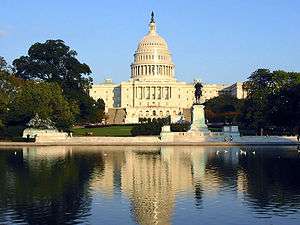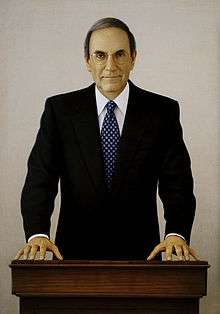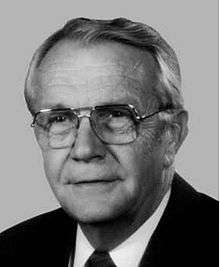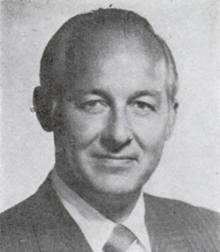103rd United States Congress
| 103rd United States Congress | |||||||||||||||||||||||||||||
| |||||||||||||||||||||||||||||
The One Hundred Third United States Congress was a meeting of the legislative branch of the United States federal government, composed of the United States Senate and the United States House of Representatives. It met in Washington, D.C. from January 3, 1993, to January 3, 1995, during the first two years of Bill Clinton's presidency. The apportionment of seats in the House of Representatives was based on the Twenty-first Census of the United States in 1990. Both chambers had a Democratic majority.
Major events
- January 20, 1993: Bill Clinton succeeded George H.W. Bush as President of the United States.
- February 26, 1993: World Trade Center bombing: In New York City, a van bomb parked below the North Tower of the World Trade Center exploded, killing 6 and injuring over 1,000.
- February 28, 1993: Waco siege: Bureau of Alcohol, Tobacco and Firearms agents raided the Branch Davidian compound in Waco, Texas, with a warrant to arrest leader David Koresh on federal firearms violations. Four agents and 5 Davidians died in the raid.
- April 19, 1993: Waco siege: The 51-day standoff ended with a fire that killed 76 people, including Koresh.
- October 3, 1993: Operation Gothic Serpent: In Mogadishu, Somalia, two U.S. Army UH-60 Blackhawks were shot down and the operation left over 1000 Somalians dead and over 73 Americans WIA, 19 KIA, and 1 captured.
- January 17, 1994: 1994 Northridge earthquake: A magnitude 6.7 quake hit the San Fernando Valley of Los Angeles at 4:31 a.m., killing 72 and leaving 26,029 homeless.
- February 22, 1994: Aldrich Ames and his wife were arrested for spying for the Soviet Union.
- February 28, 1994: 4 United States fighter jets shot down 4 Serbian jets over Bosnia and Herzegovina for violating Operation Deny Flight and its no-fly zone.
- September 19, 1994: Operation Uphold Democracy: American troops staged a bloodless invasion of Haiti to restore the elected President to power.
- October 1, 1994: Palau achieved independence and became an associated state under the Compact of Free Association.
- November 8, 1994: Republican Revolution: The Republican Party won control of both the House and the Senate in midterm congressional elections, the first time in 40 years the Republicans secured control of both houses of Congress.
Major legislation
- February 5, 1993: Family and Medical Leave Act, Pub.L. 103–3, 107 Stat. 6
- May 20, 1993: National Voter Registration Act of 1993, Pub.L. 103–31, 107 Stat. 77
- August 10, 1993: Omnibus Budget Reconciliation Act of 1993, Pub.L. 103–66, 107 Stat. 312
- November 16, 1993: Religious Freedom Restoration Act, Pub.L. 103–141, 107 Stat. 1488
- November 30, 1993: Brady Handgun Violence Prevention Act (Brady Bill), Pub.L. 103–159, title I, 107 Stat. 1536
- November 30, 1993: Don't ask, don't tell (as § 574 of the National Defense Authorization Act for Fiscal Year 1994), Pub.L. 103–160, 107 Stat. 1670
- December 8, 1993: North American Free Trade Agreement Implementation Act, Pub.L. 103–182, 107 Stat. 2057
- May 26, 1994: Freedom of Access to Clinic Entrances Act, Pub.L. 103–259, 108 Stat. 694
- September 13, 1994: Violent Crime Control and Law Enforcement Act (including the Violence Against Women Act and the Federal Assault Weapons Ban), Pub.L. 103–322, 108 Stat. 1796
- September 23, 1994: Community Development, Credit Enhancement, and Regulatory Improvement Act of 1994, Pub.L. 103–325
Party summary
Senate

| Party (shading shows control) |
Total | Vacant | ||
|---|---|---|---|---|
| Democratic (D) |
Republican (R) | |||
| End of the previous congress | 57 | 43 | 100 | 0 |
| Begin | 57 | 43 | 100 | 0 |
| End | 53 | 47 | ||
| Final voting share | 53.0% | 47.0% | ||
| Beginning of the next congress | 47 | 53 | 100 | 0 |
House of Representatives

| House seats by party holding plurality in state | |
|---|---|
80.1–100% Democratic |
80.1–100% Republican |
60.1–80% Democratic |
60.1–80% Republican |
50.1–60% Democratic |
50.1–60% Republican |
| striped: 50–50 split | |
| 1 independent | |
| Party (Shading indicates majority caucus) |
Total | ||||
|---|---|---|---|---|---|
| Democratic | Independent | Republican | Vacant | ||
| End of the previous Congress | 270 | 1 | 164 | 435 | 0 |
| Begin | 258 | 1 | 176 | 435 | 0 |
| End | 256 | 177 | 434 | 1 | |
| Final voting share | 59.2% | 40.8% | |||
| Non-voting members | 4 | 0 | 0 | 5 | 0 |
| Beginning of the next Congress | 204 | 1 | 230 | 435 | 0 |
Leadership
Senate
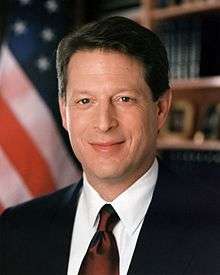

Robert Byrd (D)
- President: Dan Quayle (R), until January 20, 1993
- Al Gore (D), from January 20, 1993
- President pro tempore: Robert Byrd (D)
Majority (Democratic) leadership
- Majority Leader and Policy Committee Chairman: George Mitchell
- Majority Whip: Wendell Ford
- Senatorial Campaign Committee Chair: Bob Graham
- Caucus Secretary: David Pryor
Minority (Republican) leadership
- Minority Leader: Bob Dole
- Minority Whip: Alan Simpson
- Conference Chairman: Thad Cochran
- Policy Committee Chairman: Don Nickles
- Conference Vice Chair: Trent Lott
- National Senatorial Committee Chair: Phil Gramm
House of Representatives

Tom Foley (D)
Majority (Democratic) leadership
- Majority Leader: Dick Gephardt
- Majority Whip: David Bonior
- Caucus Chairman: Steny Hoyer
- Caucus Vice-Chairman: Vic Fazio
Minority (Republican) leadership
- Minority Leader: Bob Michel
- Minority Whip: Newt Gingrich
- Chief Deputy Whip: Bob Walker
- Conference Chair: Dick Armey
- Conference Vice-Chair: Bill McCollum
- Conference Secretary: Tom DeLay
Caucuses
- Armenian Caucus
- Biomedical Research Caucus
- Blue Dog Coalition
- Congressional Arts Caucus
- Congressional Asian Pacific American Caucus
- Congressional Automotive Caucus
- Congressional Black Caucus
- Congressional Caucus on India and Indian Americans
- Congressional Caucus on Korea
- Congressional Fire Services Caucus
- Congressional Friends of Ireland Caucus
- Congressional Hispanic Caucus
- Congressional Pediatric & Adult Hydrocephalus Caucus
- Congressional Progressive Caucus
- Congressional Travel & Tourism Caucus
- Congressional Western Caucus
- Congresswomen's Caucus
- House Democratic Caucus
- Law Enforcement Caucus
- Northern Border Caucus
Members
This list is arranged by chamber, then by state. Senators are listed in order of seniority, and Representatives are listed by district.
Senate
Senators are popularly elected statewide every two years, with one-third beginning new six-year terms with each Congress.
House of Representatives
- Alabama
- Alaska
- Arizona
- Arkansas
- California
- Colorado
- Connecticut
- Delaware
- Florida
- Georgia
- Hawaii
- Idaho
- Illinois
- Indiana
- Iowa
- Kansas
- Kentucky
- Louisiana
- Maine
- Maryland
- Massachusetts
- Michigan
- Minnesota
- Mississippi
- Missouri
- Montana
- Nebraska
- Nevada
- New Hampshire
- New Jersey
- New Mexico
- New York
- North Carolina
- North Dakota
- Ohio
- Oklahoma
- Oregon
- Pennsylvania
- Rhode Island
- South Carolina
- South Dakota
- Tennessee
- Texas
- Utah
- Vermont
- Virginia
- Washington
- West Virginia
- Wisconsin
- Wyoming
- Non-voting members
Changes in membership
Senate
| State (class) |
Vacator | Reason for change | Successor | Date of successor's formal installation |
|---|---|---|---|---|
| Texas (1) |
Lloyd Bentsen (D) | Resigned January 20, 1993, to become United States Secretary of the Treasury. His successor was appointed. |
Bob Krueger (D) | January 21, 1993 |
| Texas (1) |
Bob Krueger (D) | Interim appointee lost special election June 6, 1993. His successor was elected to finish the term. |
Kay Bailey Hutchison (R) | June 14, 1993 |
| Alabama (3) |
Richard Shelby (D) | Changed party November 9, 1994 | Richard Shelby (R) | November 9, 1994 |
| Oklahoma (2) |
David L. Boren (D) | Resigned November 15, 1994, to become President of the University of Oklahoma. His successor was elected in a special election to finish the term. |
Jim Inhofe (R) | November 17, 1994 |
| Tennessee (2) |
Harlan Mathews (D) | Interim appointee did not seek election. His successor was elected in a special election November 8, 1994, to finish the term. |
Fred Thompson (R) | December 2, 1994 |
House of Representatives
| District | Vacator | Reason for change | Successor | Date successor seated |
|---|---|---|---|---|
| Wisconsin's 1st | Les Aspin (D) | Resigned to January 20, 1993, become United States Secretary of Defense | Peter W. Barca (D) | May 4, 1993 |
| Mississippi's 2nd | Mike Espy (D) | Resigned January 22, 1993, to become United States Secretary of Agriculture | Bennie Thompson (D) | April 13, 1993 |
| California's 17th | Leon Panetta (D) | Resigned January 23, 1993, to become Director of the Office of Management and Budget | Sam Farr (D) | June 8, 1993 |
| Ohio 2nd | Bill Gradison (R) | Resigned January 31, 1993, to become president of the Health Insurance Association of America | Rob Portman (R) | May 4, 1993 |
| Michigan 3rd | Paul B. Henry (R) | Died July 31, 1993 | Vern Ehlers (R) | December 7, 1993 |
| Oklahoma's 6th | Glenn English (D) | Resigned January 7, 1994, to become CEO of the National Rural Electric Cooperative Association | Frank Lucas (R) | May 10, 1994 |
| Kentucky's 2nd | William H. Natcher (D) | Died March 29, 1994 | Ron Lewis (R) | May 24, 1994 |
| New Jersey 11th | Dean Gallo (R) | Died November 6, 1994 | Vacant for remainder of term | |
| Oklahoma's 1st | Jim Inhofe (R) | Resigned November 15, 1994, when elected to the U.S. Senate | Steve Largent (R) | November 29, 1994 |
Committees
Lists of committees and their party leaders.
Senate
- Aging (Special)
- Agriculture, Nutrition and Forestry
- Agricultural Credit
- Agricultural Research, Conservation, Forestry and General Legislation
- Conservation and Forestry
- Domestic and Foreign Marketing and Product Promotion
- Nutrition and Investigations
- Rural Development and Rural Electrification
- Appropriations
- Nuclear Deterrence, Arms Control and Defense Intelligence
- Coalition Defense and Reinforcing Forces
- Regional Defense and Contingency Forces
- Defense Technology, Acquisition and Industrial Park
- Military Readiness and Defense Infrastructure
- Armed Services
- Housing and Urban Affairs
- International Finance and Monetary Policy
- Securities
- Economic Stabilization and Rural Development
- Banking, Housing and Urban Affairs
- Housing and Urban Affairs
- International Finance and Monetary Policy
- Securities
- Economic Stabilization and Rural Development
- Budget
- Commerce, Science and Transportation
- Aviation
- Communications
- Consumer
- Foreign Commerce and Tourism
- Merchant Marine
- Science, Technology and Space
- Surface Transportation
- National Ocean Policy Study
- Energy and Natural Resources
- Energy Research and Development
- Mineral Resources Development and Production
- Public Lands, National Parks and Forests
- Renewable Energy, Energy Efficiency and Competitiveness
- Water and Power
- Environment and Public Works
- Water Resources, Transportation, Public Buildings and Economic Development
- Superfund, Recycling and Solid Waste Management
- Toxic Substances, Research and Development
- Clean Water, Fisheries and Wildlife
- Clean Air and Nuclear Regulation
- Ethics (Select)
- Finance
- Deficits, Debt Management and Long-Term Economic Growth
- Energy and Agricultural Taxation
- Health for Families and the Uninsured
- International Trade
- Medicare and Long Term Care
- Private Retirement Plans and Oversight of the Internal Revenue Service
- Social Security and Family Policy
- Taxation
- Foreign Relations
- Federal Services, Post Office and Civil Service
- International Economic Policy, Trade, Oceans and Environment
- Western Hemisphere and Peace Corps Affairs
- Terrorism, Narcotics and International Communications
- African Affairs
- Near Eastern and South Asian Affairs
- East Asian and Pacific Affairs
- Governmental Affairs
- Federal Services, Post Office and Civil Service
- General Services, Federalism and the District of Columbia
- Oversight of Government Management
- Permanent Subcommittee on Investigations
- Regulation and Government Information
- Indian Affairs
- Judiciary
- Antitrust, Monopolies and Business Rights
- Constitution
- Courts and Administration Practice
- Immigration and Refugee Affairs
- Juvenile Justice
- Patents, Copyrights and Trademarks
- Technology and the Law
- Intelligence (Select)
- Labor and Human Resources
- Labor
- Education, Arts and Humanities
- Employment and Productivity
- Disability Policy
- Children, Family, Drugs and Alcoholism
- Aging
- Rules and Administration
- Small Business
- Competitiveness, Capital Formation and Economic Opportunity
- Export Expansion and Agricultural Development
- Government Contracting and Paperwork Reduction
- Innovation, Technology and Productivity
- Rural Economy and Family Farming
- Urban and Minority-Owned Business Development
- Veterans' Affairs
House of Representatives
- Agriculture
- General Farm Commodities
- Livestock
- Specialty Crops and Natural Resources
- Department Operations and Nutrition
- Environment, Credit and Rural Development
- Foreign Agriculture and Hunger
- Appropriations
- Commerce, Justice, State and the Judiciary
- Defense
- District of Columbia
- Energy and Water Development
- Foreign Operations, Export Financing and Related Programs
- Interior
- Labor, Health, Human Services, Education and Related Agencies
- Legislative
- Military Construction
- Agriculture, Rural Development and Related Agencies
- Transportation
- Treasury, Postal Service and General Government
- VA, HUD and Independent Agencies
- Armed Services
- Military Acquisition
- Research and Development
- Readiness
- Military Forces and Personnel
- Military Installations and Facilities
- Military Personnel and Compensation
- Oversight and Investigations
- Banking, Finance and Urban Affairs
- Housing and Community Development
- Financial Institutions Supervision, Regulation and Deposit Insurance
- International Development, Finance, Trade and Monetary Policy
- Economic Growth and Credit Formation
- Consumer Credit and Insurance
- General Oversight, Investigations and the Resolution of Failed Financial Institutions
- Budget
- District of Columbia
- Fiscal Affairs and Health
- Government Operations and Metropolitan Affairs
- Judiciary and Education
- Education and Labor
- Postsecondary Education
- Health and Safety
- Labor Standards, Occupational Health and Safety
- Elementary, Secondary and Vocational Education
- Labor-Management Relations
- Human Resources
- Select Education and Rights
- Energy and Commerce
- Oversight and Investigations
- Health and the Environment
- Energy and Power
- Telecommunications and Finance
- Transportation and Hazardous Materials
- Commerce, Transportation and Competitiveness
- Foreign Affairs
- Europe and the Middle East
- Economic Policy, Trade and Environment
- International Security, International Organizations and Human Rights
- Western Hemisphere Affairs
- International Operations
- Asia and the Pacific
- Africa
- Government Operations
- Elections
- Libraries and Memorials
- Office Systems
- Accounts
- Personnel and Police
- Administrative Oversight
- House Administration
- Elections
- Libraries and Memorials
- Office Systems
- Accounts
- Personnel and Police
- Administrative Oversight
- Interior and Insular Affairs
- Economic and Commercial Law
- Civil and Constitutional Rights
- International Law, Immigration and Refugees
- Intellectual Property and Judicial Administration
- Crime and Criminal Justice
- Administrative Law and Governmental Relations
- Judiciary
- Elections
- Libraries and Memorials
- Office Systems
- Accounts
- Personnel and Police
- Administrative Oversight
- Merchant Marine and Fisheries
- Merchant Marine
- Environment and Natural Resources
- Fisheries Management
- Oceanography, Gulf of Mexico and the Outer Continental Shelf
- Coast Guard and Navigation
- Administrative Law and Governmental Relations
- Natural Resources
- Oversight and Investigations
- Native American Affairs
- Energy and Mineral Resources
- Insular and International Affairs
- Energy and Mineral Resources
- Post Office and Civil Service
- Oversight and Investigations
- Civil Affairs
- Census, Statistics and Portal Personnel
- Compensation and Employee Benefits
- Postal Operations and Services
- Public Works and Transportation
- Aviation
- Economic Development
- Investigations and Oversight
- Public Buildings and Grounds
- Surface Transportation
- Rules
- Rules of the House
- Legislative Process
- Science, Space and Technology
- Energy
- Space
- Technology, Environment and Aviation
- Science
- Investigations and Oversight
- Small Business
- SBA Legislation and the General Economy
- Regulation, Business Opportunities and Technology
- Procurement, Taxation and Tourism
- Minority Enterprise, Finance and Urban Development
- Rural Enterprises, Exports and the Environment
- Standards of Official Conduct
- Veterans' Affairs
- Education, Training and Employment
- Compensation, Pension and Insurance
- Oversight and Investigations
- Hospitals and Health Care
- Housing and Memorial Affairs
- Ways and Means
- Whole
Joint committees
Employees and legislative agency directors
Legislative branch agency directors
- Architect of the Capitol: George M. White
- Attending Physician of the United States Congress: Robert Krasner (until 1994), John F. Eisold (starting 1994)
- Comptroller General of the United States: Charles A. Bowsher
- Director of the Congressional Budget Office: Robert D. Reischauer
- Librarian of Congress: James H. Billington
- Public Printer of the United States: Robert Houk (until 1993), Michael F. DiMario (starting 1993)
Senate
- Chaplain: Richard C. Halverson
- Historian: Richard A. Baker
- Parliamentarian: Alan Frumin
- Secretary: Walter J. Stewart
- Secretary for the Majority: C. Abbott Saffold
- Secretary for the Minority: Howard O. Green, Jr.
- Sergeant at Arms: Martha S. Pope (until April 14, 1994), Robert L. Benoit (starting April 15, 1994)
House of Representatives
- Chaplain: James David Ford
- Clerk: Donnald K. Anderson
- Doorkeeper: James T. Molloy
- Historian: Ray Smock
- Parliamentarian: William H. Brown
- Sergeant at Arms: Werner W. Brandt
- Inspector General:
See also
- United States elections, 1992 (elections leading to this Congress)
- United States elections, 1994 (elections during this Congress, leading to the next Congress)
External links
- Biographical Directory of the U.S. Congress
- U.S. House of Representatives: Congressional History
- U.S. Senate: Statistics and Lists
- House of Representatives Session Calendar for the 103rd Congress (PDF).
- Congressional Pictorial Directory for the 103rd Congress.
- Official Congressional Directory for the 103rd Congress.
